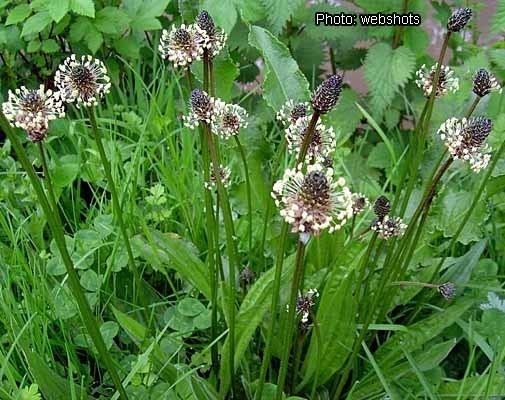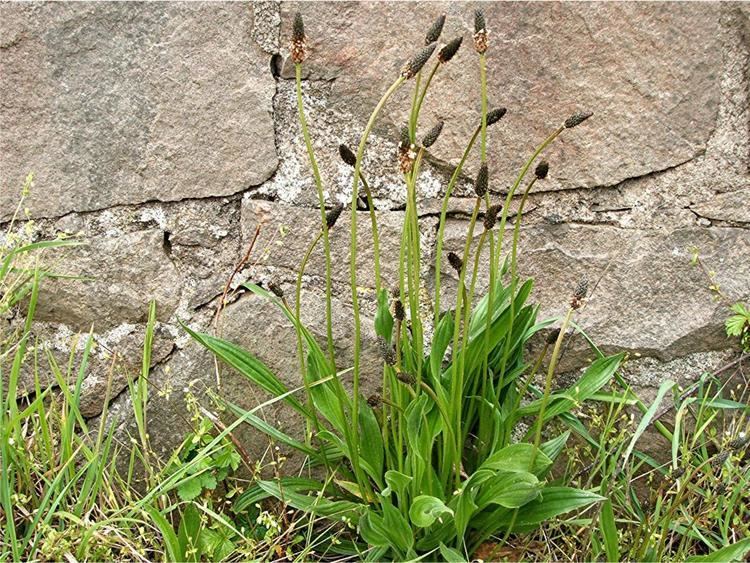Rank Species | Genus Plantago Higher classification Plantains | |
 | ||
Similar Common Dandelion, Yarrow, Common Chickenweed, Field horsetail, Red Clover | ||
Plant portrait english plantain plantago lanceolata
Plantago lanceolata is a species of flowering plant in the plantain family Plantaginaceae. It is known by the common names English plantain, narrowleaf plantain, ribwort plantain, ribleaf and lamb's tongue. It is a common weed of cultivated land.
Contents
- Plant portrait english plantain plantago lanceolata
- Wild plant food journey s 25 ribwort plantain plantago lanceolata
- Description
- Distribution
- History
- Uses
- Chemistry
- Habitat
- Reproduction
- Infection by powdery mildew
- Resistance to powdery mildew
- References

Wild plant food journey s 25 ribwort plantain plantago lanceolata
Description

The plant is a rosette-forming perennial herb, with leafless, silky, hairy flower stems (10–40 cm or 3.9–15.7 in). The basal leaves are lanceolate spreading or erect, scarcely toothed with 3-5 strong parallel veins narrowed to short petiole. Grouping leaf stalk deeply furrowed, ending in an ovoid inflorescence of many small flowers each with a pointed bract. Each flower can produce up to two seeds. Flowers 4 mm (calyx green, corolla brownish), 4 bent back lobes with brown midribs, long white stamens. Found in British Isles, scarce on acidic soils (pH < 4.5). It is considered an invasive weed in North America. It is present and widespread in the Americas and Australia as an introduced species.
Distribution

Plantago lanceolata is native to Eurasia, but has been introduced to North America and many other parts of the world with suitable habitats.
History

Considered to be an indicator of agriculture in pollen diagrams, P. lanceolata has been found in western Norway from the Early Neolithic onwards, something considered an indicator of grazing in that area.
Uses

P. lanceolata is used frequently in herbal teas and other herbal remedies. A tea from the leaves is used as a highly effective cough medicine. In the traditional Austrian medicine Plantago lanceolata leaves have been used internally (as syrup or tea) or externally (fresh leaves) for treatment of disorders of the respiratory tract, skin, insect bites, and infections.
Chemistry
P. lanceolata contains phenylethanoids such as acteoside (verbascoside), cistanoside F, lavandulifolioside, plantamajoside and isoacteoside. It also contains the iridoid glycosides aucubin and catalpol.
Habitat
Plantago lanceolata, can live anywhere from very dry meadows to places similar to a rain forest.
Reproduction
The mode of reproduction can vary among populations of P. lanceolata. Reproduction can either occur asexually via cloning or sexually, with the pollen being wind dispersed. In the populations that reproduce asexually via cloning, genetic variation is much lower than the populations that reproduce sexually.
Infection by powdery mildew
Podosphaera plantaginis is a powdery mildew fungus that infects P. lanceolata. All of the P. lanceolata populations are infected by several strains of this powdery mildew fungus. Once the populations are infected, the symptoms are minimal at first. Then, after a few months lesions start to appear covering the entire surface of the leaves and the stem, making it very noticeable.
Resistance to powdery mildew
After the populations are infected, they react in different ways. Some populations of P. lanceolata are more susceptible to different strains of powdery mildew. Also, some populations have multiple resistance phenotypes where on the other hand, others may only have one resistance phenotype. Overall, the populations that have the highest variety of resistance phenotypes will have the highest survival rates particularly when rates of infection are high.
